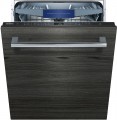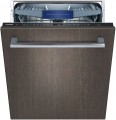Energy class
The energy efficiency class characterizes the the economy of a dishwasher's electricity consumption. Initially, the classes were denoted in Latin letters from A (high degree of economy) to G (high consumption). But later, with the development of energy saving technologies, more advanced classes than A appeared. They are denoted by the letter A with a certain number of pluses (
A+,
A++, etc.); the more benefits, the higher the economy. Most modern built-in dishwashers comply with energy classes from A to
A+++(the last is 30% more economical than the original class A). More high consumption models, such as classes B and C, are much rarer and gradually disappear.
More economical models cost more, but the difference can be recouped in energy savings. Also note that the energy consumption class does not describe efficiency in general, but in comparison with other similar models; therefore, the actual consumption of a small class A device may be lower than that of a large class A++ model.
Noise level
The approximate noise level produced by the dishwasher during operation. In modern models, this parameter can range from 37 – 39 dB (muffled human voice) to 59 – 60 dB (loud conversation); more detailed decoding of what sound corresponds to a particular number of decibels can be found in special tables. Anyway, the
low noise level contributes to the comfortable use of the device. It is especially important if the dishwasher is to be used at night (for example, if there are reduced electricity rates at night).
Controls
—
Rotary switch. Rotary switch control. Usually, it is not the only one control: the rotary knob is used to select the operating mode, and the remaining functions of the dishwasher (start-stop programs, timers, etc.) are controlled by buttons. However, panels with rotary switches still have their own specifics, so they are distinguished as a separate type of control. Technically, this option can be used in dishwashers of all price categories, but for a number of reasons, it is found mainly in inexpensive models.
—
Push-buttons. Controlled by classic mechanical buttons. This option allows you to work even with the very advanced and extensive functionality that is typical for premium dishwashers, while the buttons are cheaper than the
touch panels (see below). Therefore, push-button control can be found in all classes of dishwashers, from low-cost to top-end ones. Its main disadvantage is the presence of slots between the buttons and the panel in comparison with the same sensors, where dirt can clog and cleaning out it can be quite difficult.
— Touch. Control systems with sensors. These controls are easier to operate than simple buttons (see above) — instead of pressing, a light touch is enough. All sensors can be made under the same plane, which makes it easier to clean the control panel and reduces the number of places where dirt can clog. Do not forget t
...hat such control gives the dishwasher a modern and advanced look. On the other hand, sensors are more expensive than other types of control, and therefore are used mainly in high-end models.
